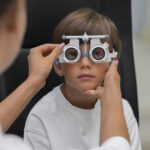Astigmatism is a common vision condition that affects both children and adults. It causes objects to appear blurry. As a parent, understanding astigmatism and how it can impact your child’s vision is crucial as it can . This guide will help you identify the symptoms, explore treatment options, and provide practical tips for managing your child’s eye health.
What is Astigmatism?
Astigmatism is a refractive error that occurs when the cornea or lens of the eye is irregularly shaped. Instead of being perfectly round, it is more conical. This irregular shape prevents light from focusing properly on the retina, resulting in blurred or distorted vision. Astigmatism can affect one or both eyes and is often present from birth.

Prevalence of Astigmatism in Children
Astigmatism is a common condition in children. Research indicates that approximately 23% of children under the age of 1 year have astigmatism in the United States. This drops to 9% for kids in the age group of 5-6 years.
So, while astigmatism may get better among some kids, it is important to regularly monitor their eyesight for effective treatment.
Causes and Symptoms
Astigmatism is often hereditary and can be present at birth. It is also commonly observed along with other vision issues like myopia (near-sightedness) and hyperopia (far-sightedness). However, it can also develop after an eye injury, disease, or surgery. Here are some common symptoms to watch for:
- Blurred or distorted vision
- Headaches or eye strain
- Difficulty reading or focusing on close tasks
- Squinting or closing one eye to see better
- Frequent complaints of tired eyes
Diagnosis and Treatment
Diagnosing astigmatism in children requires a comprehensive eye exam by an optometrist or ophthalmologist. Early detection is key to preventing potential learning difficulties and developmental delays.
Treatment options typically include:
- Eyeglasses: The most common and simplest solution for correcting astigmatism.
- Contact Lenses: Special toric lenses designed to correct astigmatism.
- Refractive Surgery: In some cases, surgery like LASIK may be considered for older teens.
Can Astigmatism Be Cured?
Currently, there is no permanent cure for astigmatism. However, it can be effectively managed with corrective lenses or refractive surgery. As mentioned previously, in some children, astigmatism may reduce as they grow and the shape of their eyes changes. However, it is always best to monitor it.
Impact on Learning and Development
Untreated astigmatism can significantly impact a child’s ability to learn and participate in activities. Children with undiagnosed vision issues may struggle with reading, writing, and other tasks that require visual focus, leading to frustration and a lack of confidence in school.
Tips for Parents
- Regular Eye Exams: Ensure your child has regular eye exams, especially if there is a family history of vision problems or they have other conditions like myopia and hyperopia. Read our blog on eye exams for more details
- Encourage Glasses Use: Ensure they wear glasses or contact lenses as much as possible to minimise the strain on their eyes. Use positive reinforcement like telling them they look good in glasses, if needed
- Monitor Screen Time: Limit screen time and ensure your child takes regular breaks to reduce eye strain. Read our blog on managing screen time for more details
- Prevent Eye Rubbing: Discourage your child from rubbing their eyes frequently. Rubbing can irritate the eyes, worsen astigmatism. It may even lead to keratoconus, a more serious condition where the cornea becomes cone-shaped. Read about my battle with keratoconus which led me to start this blog
- Ensure good lighting: All activities, especially reading and writing, should be done in a well-lit environment.
Foods and Exercises to Help with Astigmatism
While no specific foods or exercises can cure astigmatism, a healthy diet and regular eye exercises can support overall eye health:
- Diet: Include foods rich in omega-3 fatty acids (such as fish), vitamin A (such as carrots and sweet potatoes), and antioxidants (such as leafy greens and berries) to support eye health.
- Exercises: Encourage regular breaks from screen time and activities that involve focusing on distant objects. Simple eye exercises, like focusing on a distant object and then a near object, can help reduce eye strain.
Conclusion
Astigmatism is a manageable condition with the right approach and care. If you suspect your child may have vision problems, seek professional advice promptly. Early diagnosis and treatment can make a significant difference in your child’s learning and quality of life.
Join Our Community
Stay updated and swap tips with other parents by joining our WhatsApp group. Share this post with fellow parents and invite them to join too. Together, let’s keep our kids’ precious little eyes healthy.




